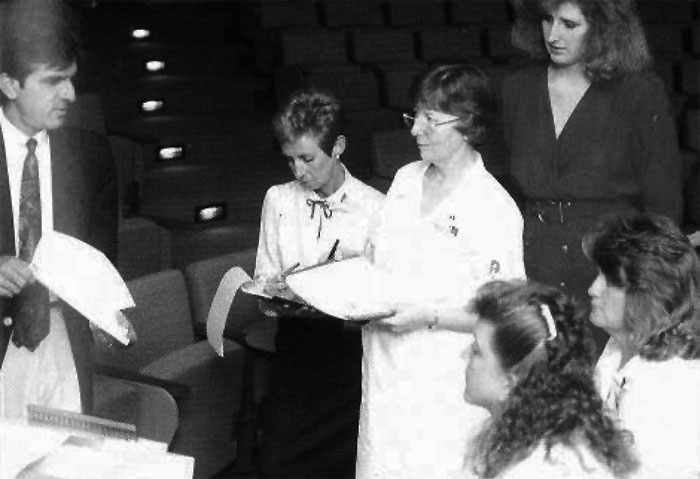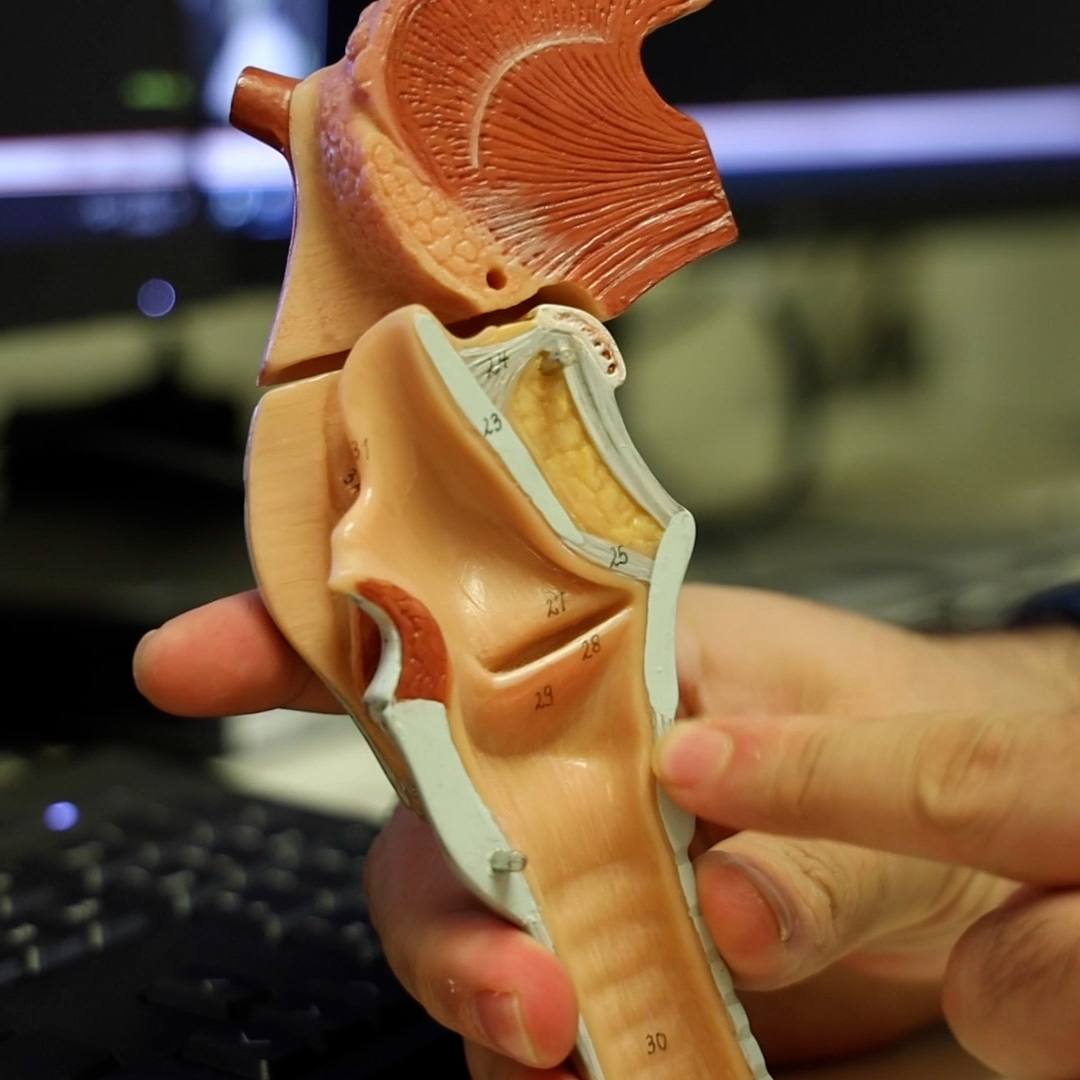-
Featured News
#FlashbackFriday 1990: Fiber-optic cable launches integration

This article first appeared in September 1990, in the publication Mayovox.
More than 100 people from Rochester, Scottsdale and Jacksonville have teamed up in a successful computer-system effort that benefits Mayo Clinic patients at all three locations.
Mayo opened clinics in Jacksonville and Scottsdale in 1986 and 1987, respectively. Each clinic started operation using independent computers and programs to provide registration, scheduling, order entry and patient accounting functions. Although the computers were right for start up operations, they soon became overloaded by the clinics’ rapid growth, resulting in data-processing delays.
Two options were considered to overcome the computers’ limited capacity. The first was to replace the equipment at each location with large-capacity computers. The second was to connect the large-capacity mainframe computers already in Rochester to new, compatible terminals and printers in Jacksonville and Scottsdale by extending the Institutional Data Network (I-NET) from Rochester to each location. The latter option was selected for its economic and functional merits.
Planning for the network began in mid-1989. In January the assignment was issued to implement and extend I-NET to Jacksonville and Scottsdale.
The portion of I-NET at each location is referred to as a local-area network. The link between sites is referred to as a wide-area network. Together they are I-NET, a data communications system that enables easy and fast exchange of information among Mayo computers no matter where they are located. I-NET was an essential first step before Scottsdale and Jacksonville computer programs could be moved to Rochester.
The new system, using Scottsdale’s and Jacksonville’s original programs on the Rochester computers and I-NET became reality for Mayo Clinic Jacksonville on June 25. Mayo Clinic Scottsdale converted to the new system Aug. 27.
The decision to use Rochester computers and I-NET was the culmination of a proposal developed cooperatively by Tom Rau, Rochester; Scott Seinola, Jacksonville; Andrea Yardley, Scottsdale; and several others.
“Self interests and egos were set aside and everyone worked together to develop the right computer-system solution,” says Rau, Information Services, Mayo Rochester. “All Mayo people involved from proposal to approval, and from design to implementation, ultimately put the Mayo System’s best interests above any local concerns.”
I-NET links connecting Rochester, Jacksonville and Scottsdale are fiber-optic cable, referred to as a T-1 cable. While T-1 cable has been used for telephone communications at Mayo since November 1989, this is the first large-scale use of it for data communications. The fiber-optic network portion of the project was led by Telecommunications Engineer Jim Miller, Mayo Clinic Rochester. “We’ve leased high-speed fiber-optic service that provides voice and data-transmission capabilities among all three sites,” Miller says.
Les Huie, Mayo Rochester Engineering, directed the installation of cabling and equipment at Scottsdale and Jacksonville.
“The first obstacle we overcame was the ‘yours’ and ‘mine’ mindset,” says Abdul Bengali, Information Services, Rochester. “Before we could begin, we had to establish I-NET as everyone’s system, regardless of location.”
Teamwork was crucial throughout the project, according to Bengali. “We were geographically far apart, yet we needed to draw on the expertise at the various sites,” he says. “Since we were trying to combine previously independent systems, a collaborative and cooperative approach was a must.
“One of the first things we had to do was talk with the people who would be using the new system,” Bengali says. “In order to design the system to benefit our Jacksonville and Scottsdale colleagues, we had to be aware of their needs. At this point, literally hundreds of employees became involved.” Some of the areas benefiting from I-NET include: Accounting, Personnel, Patient Registration, Information Systems, Appointment Scheduling, Medical Library and Administration.
“The importance of I-NET is that it fosters effective communication among the three sites,” says Dr. Richard Hill, chair of the Board of Governors, Mayo Clinic Scottsdale. “The network allows us to be online with one another and thus communicate in all ways, 24 hours a day.”
Dr. Leo Black, chair of the Board of Governors, Mayo Clinic Jacksonville, says: “The conversion went superbly. I talked with some employees a few days later and all I heard was that it was a very smooth changeover and the new system was working great.”
“The most significant improvement over the old system is response time,” says Bengali. “In the past, CRT-terminal responses could take minutes. With the new system, that time has been reduced to a second or two in the majority of cases.”
“The new system really increases productivity,” says Sue Morrison, supervisor of Appointment Scheduling at Mayo Scottsdale. “With the old system, it could take us 30 minutes to develop an appointment itinerary for a patient. The new system reduces that time substantially.”
“The biggest impact I see is on employee morale — especially for employees who use the system on a day-to-day basis,” says Yardley, Information Systems, Scottsdale. “The limits of the old computers created frustration for employees, and in the end, patients.”
Training for the new system was conducted for approximately 300 employees in Jacksonville and 400 in Scottsdale. One instructor at Jacksonville was Scott Schramm, supervisor of float desk attendants. “The training was conducted by two instructors; one from the desk area and one from the data processing area. That way, employees got answers to specific questions,” he explains. “Once employees became familiar with the computers’ keyboards and screens, they were thrilled with the system’s response.”
Yvonne Simpson, Registration/Admissions at Mayo Jacksonville, participated in the training. “While I was apprehensive at first, I found that the training coupled with hands-on experience made it all come together. The new system is so much faster,” she says. In the photo above, Bengali leads a training session in Scottsdale, explaining additional capabilities for the new printers to (clockwise from left): Arlis Borgstrom, Information Services; Marilyn Formichella, Medical Records; Tammy Schade, Information Services; Karin Wallgren, Appointment Scheduling; and Susan Vold, Desk 3A.
Dr. Robert Tancredi, chair of the Information Systems Management Committee, is enthusiastic about the network. “As a major challenge for the coming decade, we will be developing an integrated system for patient care, research and education that unites the three sites,” he says. “This network is the foundation, providing fast and easy access to data bases in a way that makes geographic distances transparent.”
“Obviously, teamwork and shared beliefs in Mayo among Rochester, Jacksonville and Scottsdale were key ingredients to the successful extension of I-NET and the new computer systems for Jacksonville and Scottsdale,” Rau concludes. “This project reflects Mayo’s commitment to providing integrated health care through comprehensive voice, video, and data communication systems linking all three sites.
Related Articles







